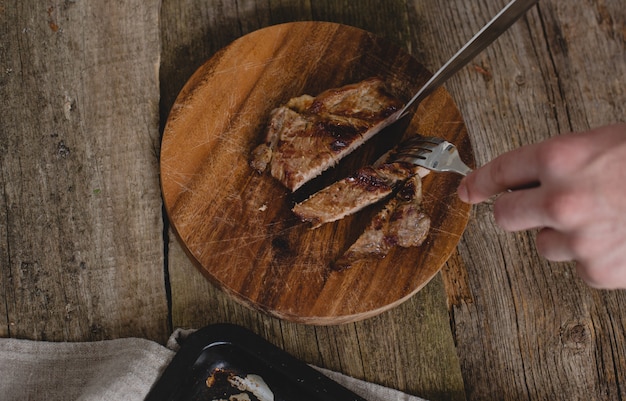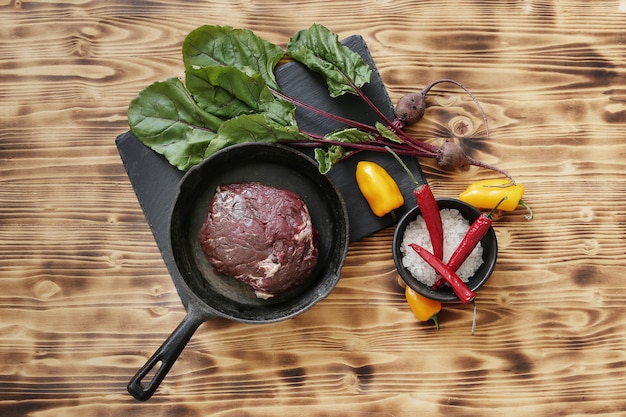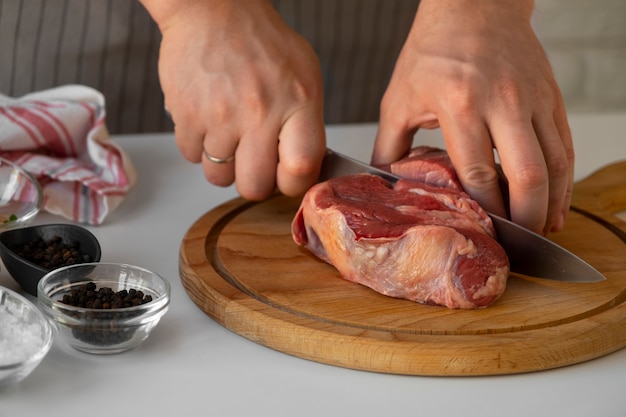There's a reason why the phrase "perfectly cooked steak" conjures up images of pure culinary bliss. That satisfying sizzle, the tantalizing aroma, and the contrast of a crisp, caramelized exterior with a tender, juicy interior – it's a symphony of textures and flavors that simply can't be replicated. But achieving that coveted medium-well doneness, with just the right amount of pink and a hint of char, can sometimes feel like a culinary gamble. I've been there, countless times, staring at a sizzling steak, wondering if I've overcooked it, or worse, left it raw.
Over the years, I've learned that mastering the art of cooking steak is more about understanding the process and having the right tools than it is about having some kind of mystical, culinary sixth sense. It's about understanding the science behind how heat affects protein, knowing the nuances of different cuts, and embracing a touch of intuition. This article is my attempt to demystify the art of cooking medium-well steak, sharing the tips, tricks, and techniques I've gathered along the way. So, grab your apron, gather your ingredients, and let's embark on this culinary journey together.
Part 1: choosing the right steak

The first step to a perfect medium-well steak is selecting the right cut. Now, I'm not going to bore you with a long, technical explanation about the anatomy of a cow. Just remember, you want something that's going to hold up well under heat, and will be tender and flavorful. My personal favorites are:
1. Ribeye
Ribeye is a classic choice for a reason. It’s marbled, meaning it has a good amount of fat, which contributes to its richness and tenderness. And that fat renders beautifully when cooked, creating a melt-in-your-mouth experience. Just make sure to trim any excess fat before cooking. For a truly impressive presentation, consider a bone-in ribeye, which adds a touch of rustic elegance.
This cut is leaner than ribeye, with a more pronounced flavor. It’s great for those who prefer a bit more "bite" in their steak. The flavor is also concentrated in the centre, making it a great choice for grilling or pan-frying. The New York strip is also known for its beautiful, even shape, which makes it easy to cook and slice.
3. Sirloin
Sirloin is a versatile cut that’s typically more affordable than ribeye and New York strip. It’s a good option for those who are new to cooking steak, as it’s relatively forgiving. Just be sure to cook it at a lower temperature and for a shorter time than the other cuts. Sirloin can be a little less tender than the other options, so consider marinating it for a few hours to add moisture and flavor.
Part 2: Prepping Your Steak

Now that you've got your cut, let's get it ready for cooking. Here's what I do:
1. Pat it Dry
This step is crucial! A wet steak will steam rather than sear, resulting in a soggy, unevenly cooked steak. Use paper towels to pat the steak dry, making sure to get all the moisture off. This ensures that the surface is dry and ready to develop a beautiful, crispy crust.
2. Season Simply
Salt and pepper are your best friends when it comes to seasoning steak. Avoid over-seasoning - just a light coating is all you need. The salt helps to draw out moisture and enhance the natural flavors of the steak. A fresh grind of black pepper adds a touch of complexity and warmth. You can also add other spices, like garlic powder, onion powder, or paprika, but I prefer to keep it simple and let the natural flavors of the steak shine.
3. Let it Rest
This is a crucial step that many people skip, but it's a game-changer! Letting your steak rest at room temperature for 30 minutes allows the internal temperature to even out, resulting in a more evenly cooked steak. This also helps to prevent the steak from shocking when it hits the hot pan, which can lead to uneven cooking.
Part 3: The Art of Searing

Searing is the key to a perfectly cooked medium-well steak. This process creates a beautiful crust, locking in the juices and flavour. Here's how to do it right:
1. Choose Your Weapon
For this step, I prefer a cast iron skillet. The heavy base distributes heat evenly, and the iron retains heat well, ensuring a consistent sear. You can also use a grill pan or a heavy-bottomed stainless steel pan. The key is to choose a pan that can withstand high heat and won't warp or buckle under pressure.
2. Preheat Your Pan
Heat your pan over medium-high heat for about 5-7 minutes. You should be able to see wisps of smoke coming from the pan, indicating that it's hot enough. A hot pan is essential for achieving that desirable crust. If the pan isn't hot enough, the steak will steam rather than sear.
3. Sear on High
Place your steak in the hot pan and don't move it for about 2-3 minutes per side. This allows the steak to develop a beautiful, crispy crust without overcooking the inside. Resist the urge to move the steak around during the sear. Let it sit undisturbed so the proteins can properly bond and create that delicious, crusty exterior.
4. Flip it
Once the first side is seared, flip the steak and sear the other side for 2-3 minutes. Remember to let the steak rest in the pan before flipping for the perfect sear. This allows the proteins on the bottom to set, ensuring that the steak releases easily from the pan without sticking.
Part 4: Bringing It to Medium-Well
Now that your steak has a lovely crust, it's time to bring it to medium-well. This is where things can get a bit tricky, but with a few tips, you'll be a master in no time.
1. Reduce the Heat
Once you’ve seared both sides, lower the heat to medium. We don’t want to overcook the steak, just bring it to the desired level of doneness. Reducing the heat ensures that the steak cooks evenly without burning the outside.
2. Cook to Your Preference
For medium-well, you're looking for an internal temperature of 145-150°F. This means the steak will have a hint of pink in the centre, but will be cooked through. The exact internal temperature for medium-well can vary slightly depending on personal preference. However, 145-150°F is a good general guideline for a steak that is cooked through, but still retains some of its natural juiciness.
3. Use a Thermometer
A meat thermometer is essential for ensuring that your steak is cooked to perfection. Insert the thermometer into the thickest part of the steak, making sure it doesn't touch any bone. A meat thermometer eliminates any guesswork and ensures that your steak is cooked to your exact specifications. This is especially important when cooking steak for multiple people, as each person may have different preferences for doneness.
4. Rest and Enjoy
Once the steak reaches the desired internal temperature, remove it from the pan and let it rest for 5-10 minutes before slicing and serving. This allows the juices to redistribute, resulting in a more tender and flavorful steak. Resting the steak is crucial for retaining its moisture and maximizing tenderness. The juices will be evenly distributed throughout the steak, resulting in a more flavorful and enjoyable eating experience.
Part 5: Beyond the Basics
So, you've mastered the basics. Now let's add a little flair to your medium-well steak experience!
1. Herbs and Spices
Don't be afraid to experiment with different herbs and spices! A simple sprinkle of thyme or rosemary can elevate the flavour of your steak. You can also use garlic powder, onion powder, or paprika. Just be mindful of the amount you use, as you don't want to overwhelm the natural flavors of the steak. Experiment with different combinations to find your perfect blend.
2. Marinades
Marinades are a great way to add flavour and moisture to your steak. You can find pre-made marinades at the grocery store, or make your own from scratch. I love a simple marinade of olive oil, lemon juice, garlic, and herbs. Marinades can also help to tenderize tougher cuts of meat, making them more flavorful and enjoyable. Be sure to marinate for at least 30 minutes, or ideally, overnight for maximum flavor infusion.
3. Sauces
The right sauce can make a medium-well steak truly exceptional. I like to keep it simple with a classic Béarnaise sauce, or a rich, creamy mushroom sauce. A sprinkle of fresh herbs like parsley or chives adds a touch of freshness. Sauces add another layer of complexity and flavor to your steak. Experiment with different sauces to find your favorite combinations. A simple pan sauce made with the drippings from the steak can also be incredibly delicious.
Part 6: Mastering the Grill
If you prefer the smoky flavour of a grilled steak, here’s a quick guide:
1. Preheat Your Grill
Heat your grill to medium-high heat. A charcoal grill is ideal for that smoky flavour, but you can also use a gas grill. Make sure the grill grates are clean and well-oiled to prevent sticking. A preheated grill ensures even cooking and prevents the steak from sticking to the grates. For a gas grill, heat the burners to medium-high heat for about 10-15 minutes before placing the steak on the grill. For a charcoal grill, ensure that the coals are glowing red and covered with a layer of ash before placing the steak on the grill.
2. Sear It First
As with pan-frying, sear your steak over direct heat for 2-3 minutes per side to create a delicious crust. This creates those beautiful grill marks and locks in the juices, resulting in a tender and flavorful steak.
3. Move to Indirect Heat
Once seared, move the steak to indirect heat to finish cooking. This will prevent the steak from burning while it reaches the desired internal temperature. Indirect heat refers to cooking the steak away from the direct heat of the flames, allowing for a more even cooking process. This is especially important for thicker cuts of steak, as they need to cook through without burning the outside. On a gas grill, turn off one or two burners and place the steak over the unlit burners. On a charcoal grill, move the steak to the edge of the grill where the coals are not directly beneath it.
4. Watch Your Temps
Just like with pan-frying, use a meat thermometer to ensure your steak reaches the desired internal temperature. You can use a digital thermometer or an instant-read thermometer. A meat thermometer ensures that your steak is cooked to your exact specifications. This is especially important when cooking steak on a grill, as the heat can be uneven and it's difficult to judge the doneness by visual inspection alone.
5. Rest and Serve
Once cooked, remove the steak from the grill and let it rest for 5-10 minutes before slicing and serving. This allows the juices to redistribute, resulting in a more tender and flavorful steak. Resting the steak allows the juices to redistribute throughout the muscle fibers, resulting in a more tender and flavorful steak. If you're serving the steak with a sauce, let it cool slightly before slicing and serve with your favorite sides.
Part 7: Cooking for a Crowd
Serving a medium-well steak to multiple people requires a little more planning.
1. Choose the Right Cut
When cooking for a group, consider choosing a larger cut, like a tomahawk steak or a ribeye roast. These cuts can be shared amongst several people and often have a higher marbling, which makes for a more flavorful and tender steak. Larger cuts of steak also tend to be more forgiving, as they have a greater surface area to cook evenly.
2. Use a Thermometer
Having multiple thermometers will help ensure that each steak is cooked to your guests’ desired levels of doneness. This eliminates any guesswork and keeps everyone happy. Having multiple thermometers will eliminate any guesswork and ensure that each steak is cooked to your guests’ exact specifications. This is especially important when you have guests with different preferences for doneness. If you have a large group, consider assigning a “steak chef” to monitor the cooking process and ensure that each steak is cooked to the desired level of doneness.
3. Create a "Steak Station"
Set up a "steak station" where guests can customize their steak with sauces, seasonings, and sides. This allows everyone to create the perfect steak experience for themselves. A steak station is a great way to allow guests to personalize their steak experience. You can provide a variety of sauces, seasonings, and sides to choose from, such as different mustards, salts, peppers, herbs, and vegetables. This is a great way to cater to different tastes and preferences, and ensures that everyone has a satisfying and delicious meal.
Part 8: Frequently Asked Questions (FAQs)
Here are some common questions about cooking a medium-well steak, along with my answers.
1. How can I tell if my steak is done without using a thermometer?
While a thermometer is the most accurate way to tell, you can use the touch method to get an idea. Gently press the steak with your finger. If it feels firm, it’s medium-well. However, this method is not as precise as using a thermometer and is best used as a general guide.
2. What if I overcook my steak?
Don’t worry, it happens to the best of us! If your steak is overcooked, it’s not a total disaster. Slice it thinly and serve it with a rich sauce to compensate for the dryness. Overcooked steak can be a little dry, but it can still be delicious. A rich sauce can help to add moisture and flavor, while thinly slicing the steak can help to make it more tender. Consider serving it with a creamy or savory sauce, such as a mushroom sauce, béarnaise sauce, or chimichurri sauce.
3. Can I cook a medium-well steak in the oven?
Yes, you can cook a steak in the oven. Preheat your oven to 400°F, sear the steak on the stovetop, then transfer it to the oven for about 10-15 minutes, or until it reaches the desired internal temperature. Cooking a steak in the oven is a great option if you prefer a more hands-off approach or if you're cooking a larger steak. The oven provides consistent heat and ensures that the steak cooks evenly throughout.
4. What are the best sides to serve with a medium-well steak?
The best sides for a medium-well steak are those that complement its rich flavour and tender texture. I love serving it with roasted vegetables, mashed potatoes, creamy polenta, or a simple green salad. Sides should be chosen to create a balance of flavors and textures. Roasted vegetables, such as asparagus, Brussels sprouts, or broccoli, add a contrasting sweetness and earthiness. Mashed potatoes provide a creamy and comforting element. Creamy polenta is a rich and satisfying side that pairs well with the richness of the steak. And a simple green salad adds a touch of freshness and lightness.
5. What are some tips for making a delicious steak sauce?
For a simple steak sauce, combine Dijon mustard, Worcestershire sauce, red wine vinegar, and a splash of water. Simmer until thickened, then add a knob of butter and season with salt and pepper. A simple steak sauce can be made with just a few ingredients. You can also add other ingredients, such as chopped shallots, garlic, or herbs, to enhance the flavor. For a richer sauce, consider using a demi-glace or a pan sauce made with the drippings from the steak.
Part 9: Conclusion
There you have it, my comprehensive guide to cooking the perfect medium-well steak. Remember, cooking a steak is a journey, not a destination. Don't be afraid to experiment and find what works best for you. So, put on your apron, gather your ingredients, and embrace the joy of creating a culinary masterpiece!
Everyone is watching

How to Cook Frozen Lobster Tails Perfectly: A Step-by-Step Guide
RecipesLobster. Just the word conjures up images of lavish meals, special occasions, and a taste of luxury. But let's...

Pigs in a Blanket Cooking Time: How Long to Bake for Perfect Results
RecipesAh, pigs in a blanket. Just the name conjures up images of those delightful little parcels of crispy pastry en...

Pork Fillet Cooking Time: How Long to Cook It Perfectly
RecipesPork fillet, or tenderloin as it's sometimes called, is a real favourite in our house. It's so versatile, and...

The Ultimate Guide to Cooking Sweet Potatoes: From Roasting to Mashing
RecipesSweet potatoes. Just the name conjures up images of warm, comforting dishes, bursts of vibrant color, and a to...

The Ultimate Guide to Tender, Juicy Pulled Pork
RecipesRight, let's talk pulled pork. It's one of those dishes that just screams "comfort food," doesn't it? I mean...
